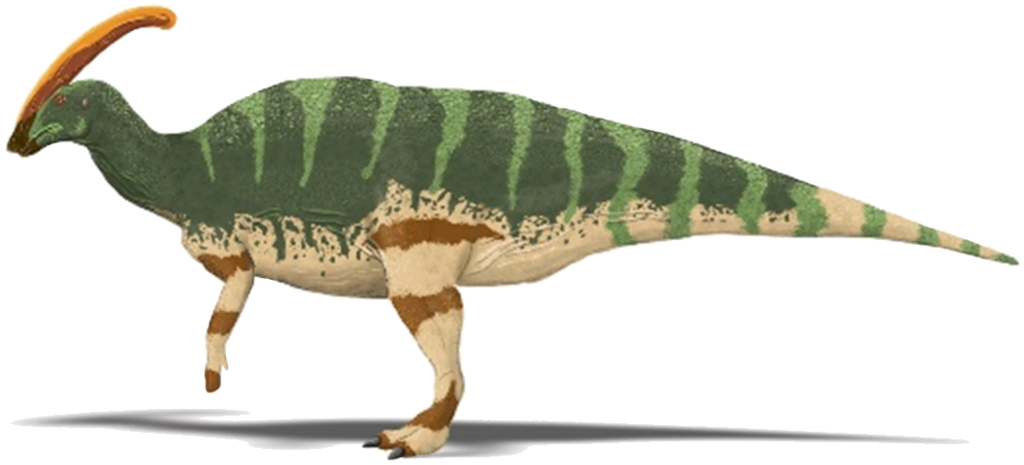Dinosaurs, those magnificent creatures that once dominated our planet, continue to fascinate us with their diverse and often bizarre anatomical features. Among their most striking characteristics were the elaborate crests that adorned the heads of various species. These weren’t merely decorative—they served crucial biological functions that helped these animals survive and thrive in their prehistoric environments. From hollow chambers that amplified sounds to thermal regulators and visual displays for attracting mates, dinosaur crests represent some of the most remarkable adaptations in the fossil record. Let’s explore these extraordinary structures and uncover the evolutionary purposes behind their development.
The Flamboyant Parasaurolophus and Its Sound Chamber
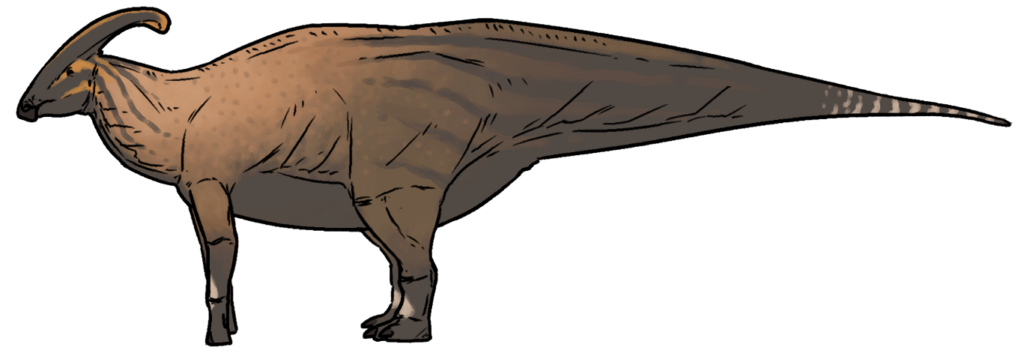
Perhaps the most iconic crested dinosaur, Parasaurolophus, walked the Earth during the Late Cretaceous period approximately 76.5-73 million years ago. Its most distinctive feature was an elongated tubular crest that curved backward from its skull, reaching lengths of up to six feet in some specimens. Far from being merely ornamental, this hollow tube-like structure served as an intricate sound resonating chamber. Scientists believe that when Parasaurolophus exhaled through this crest, it created deep, resonant calls that could travel across great distances through prehistoric forests and plains. Computer models and reconstructions suggest these sounds may have been similar to the low-frequency calls of modern elephants or the resonant tones of brass instruments, allowing these herbivores to communicate with their herd members even when separated by considerable distances. This adaptation would have been particularly valuable for maintaining group cohesion and warning others about approaching predators in densely vegetated environments.
Corythosaurus and Its Helmet-Like Crest

The Corythosaurus, whose name means “helmet lizard,” sported a distinctive compressed crest that resembled a Corinthian helmet worn by ancient Greek warriors. This hadrosaur lived during the Late Cretaceous period, approximately 77-75.7 million years ago in what is now North America. Unlike some other crested dinosaurs, the Corythosaurus had a crest that was relatively tall and narrow, forming an arc-like shape above its head. Detailed examinations of fossilized specimens reveal that this crest contained elaborate nasal passages that wound through the structure in a complex pattern. These passages likely enhanced the dinosaur’s sense of smell, a crucial adaptation for detecting both food sources and potential predators. Additionally, the crest housed enlarged nasal chambers that probably served as resonating chambers for producing distinctive vocalizations, allowing for species recognition and communication among members of the same species across the ancient landscapes they inhabited.
The Bizarre Fan-Crested Olorotitan
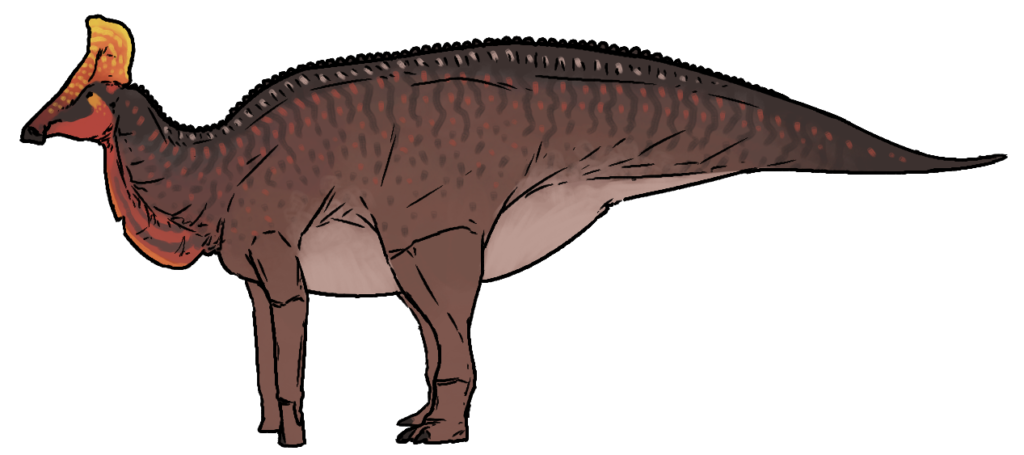
Among the most unusual crested dinosaurs was the Olorotitan, a hadrosaur from the Late Cretaceous period that lived in what is now Russia’s Far East. What makes Olorotitan truly remarkable is its elaborate hatchet-shaped or fan-like crest that extends dramatically from the back of its skull. Unlike the hollow crests of Parasaurolophus, the Olorotitan’s crest was solid and considerably broader, forming a distinctive fan shape that would have been highly visible from various angles. Given its solid structure, scientists believe this crest likely evolved primarily for visual display purposes rather than sound production. The dramatic shape and size suggest it played a significant role in species recognition, allowing individuals to identify potential mates from their species even in diverse dinosaur communities. Additionally, the crest may have served as a display structure during courtship rituals, with larger or more vibrantly colored crests potentially signaling genetic fitness to potential mates in a form of sexual selection similar to the tail of a modern peacock.
Tsintaosaurus: The Controversial “Unicorn” Crest

Few dinosaur crests have generated as much scientific debate as the peculiar projection found on Tsintaosaurus, a hadrosaur that lived approximately 70 million years ago in what is now China. When first discovered, paleontologists reconstructed Tsintaosaurus with a single, forward-pointing, spike-like crest, earning it the nickname “unicorn dinosaur.” This unusual interpretation persisted for decades until more complete fossil specimens and advanced analysis techniques led to a revised understanding. Modern interpretations suggest that the crest was more similar to those of other lambeosaurine hadrosaurs, likely forming an arched or hook-like structure rather than a straight spike. Despite this revision, Tsintaosaurus still possessed one of the most distinctive head ornamentations among dinosaurs. The internal structure of the crest contained complex nasal passages, suggesting it functioned both for respiratory purposes and as a resonating chamber for producing species-specific vocalizations that would have echoed across its Late Cretaceous habitat, serving crucial roles in territorial displays and mating behaviors.
Lambeosaurus and Its Hatchet-Hollow Hybrid
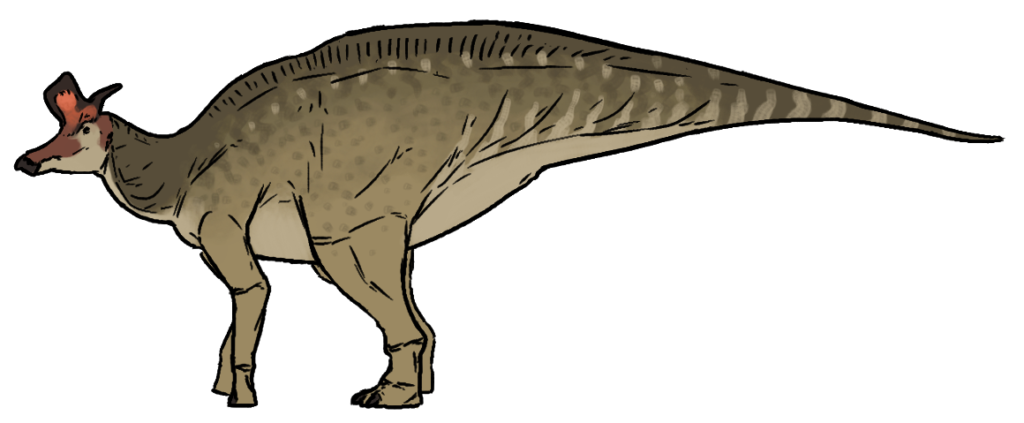
Lambeosaurus presents one of the most fascinating crest configurations found among dinosaurs, combining elements seen in several other species into a single extraordinary structure. Living during the Late Cretaceous period approximately 76-75 million years ago, this genus of hadrosaur possessed a crest that resembled a hatchet blade with a hollow extension protruding backward from its skull. This complex anatomical feature varied between species within the genus, with some specimens displaying more elaborate crests than others. The hollow portion of the crest contained intricate nasal passages that likely served as resonating chambers for producing distinctive calls. Paleontological evidence suggests these passages were connected to the respiratory system, allowing Lambeosaurus to produce sounds by forcing air through them during exhalation. Beyond vocalization, the crest’s distinctive shape would have made individuals easily recognizable to others of their species from considerable distances. This visual signaling component would have been particularly valuable during breeding seasons when identifying suitable mates of the correct species would have been essential for reproductive success.
Dilophosaurus and Its Double-Crested Mystery

Made famous by its fictional portrayal in Jurassic Park,” the real Dilophosaurus differed significantly from its on-screen counterpart, though its actual features were no less remarkable. This Early Jurassic predator, living approximately 193 million years ago, possessed two thin, parallel crests that ran longitudinally along the top of its skull, giving it the name Dilophosaurus, which means “two-crested lizard.” Unlike the hollow sound-producing crests of hadrosaurs, Dilophosaurus had solid crests that were too delicate to have served any protective function. The fragility of these structures has led paleontologists to conclude they most likely evolved as display features for species recognition and sexual selection. The vibrant coloration these crests likely displayed would have made dominant males stand out during courtship displays, potentially indicating genetic fitness to potential mates. Some researchers have also suggested the crests may have played a role in regulating body temperature, with blood vessels near the surface of the thin crests potentially allowing for heat exchange with the environment—though this remains one of the more speculative theories about this enigmatic dinosaur’s distinctive headgear.
Cryolophosaurus: The Antarctic “Frozen Crest” Dinosaur

Discovered in Antarctica and dating from the Early Jurassic period approximately 190 million years ago, Cryolophosaurus bears one of the most distinctive cranial ornamentations ever found on a dinosaur. Unlike the backward-sweeping crests of hadrosaurs, Cryolophosaurus possessed a remarkable sideways-oriented crest that ran across its head from side to side rather than from front to back. This unique orientation created what some paleontologists have informally called an “Elvis pompadour” due to its resemblance to the iconic hairstyle of Elvis Presley. As one of the earliest known crested theropod dinosaurs, Cryolophosaurus provides valuable insights into the evolution of cranial displays among dinosaur lineages. The solid, bony crest appears to have been primarily a visual display structure rather than serving any acoustic function. Given the relatively small population sizes that likely existed in the polar environments of Jurassic Antarctica, such distinctive visual signals would have been particularly important for finding potential mates in a challenging habitat where individuals might have been widely dispersed, making this crest an essential adaptation for reproductive success in its unique environment.
Monolophosaurus and Its Single Ridge Crest

Hailing from the Middle Jurassic period of what is now China, approximately 170-160 million years ago, Monolophosaurus sported a single, prominent crest that ran along the midline of its skull from the snout to just before the eyes. Unlike the elaborate horns or tubes seen in other crested dinosaurs, this theropod’s ornamentation consisted of a relatively simple yet distinctive ridge formed by extended nasal and lacrimal bones. Despite its comparative simplicity, this crest would have given Monolophosaurus a striking profile that distinguished it from other contemporary predators. The solid nature of this crest suggests it wasn’t used for sound production but rather served visual signaling functions. As a medium-sized predator reaching lengths of about 16 feet, Monolophosaurus likely used its crest during intimidation displays against rivals or competing predators. The crest may have appeared larger and more imposing when the dinosaur lowered its head in a threatening posture, potentially helping it to establish dominance without risking dangerous physical confrontations with competitors over territory or food resources.
Saurolophus and Its Spike-Like Projection

Saurolophus, whose remains have been found across both North America and Asia from the Late Cretaceous period approximately 70 million years ago, possessed a distinctive spike-like crest that projected backward from the top of its skull. Unlike the hollow, elaborate crests of many other hadrosaurs, the Saurolophus crest was relatively solid and spike-shaped, consisting primarily of the animal’s nasal bones extended upward and backward. This comparatively simpler structure has generated significant debate among paleontologists regarding its primary function. While lacking the complex internal chambers that would suggest a primary role in sound production, the crest did contain some nasal passages that might have played a secondary role in vocalization. More likely, this prominent feature served as a visual signal for species recognition, allowing these large herbivores to identify potential mates from a distance across the open environments they inhabited. Some researchers have also proposed thermoregulatory functions, suggesting that blood vessels running through the crest might have helped cool the animal’s brain during intense activity or in warmer climates—an adaptation that would have been particularly valuable for these large-bodied dinosaurs.
The Enigmatic Crest of Amargasaurus
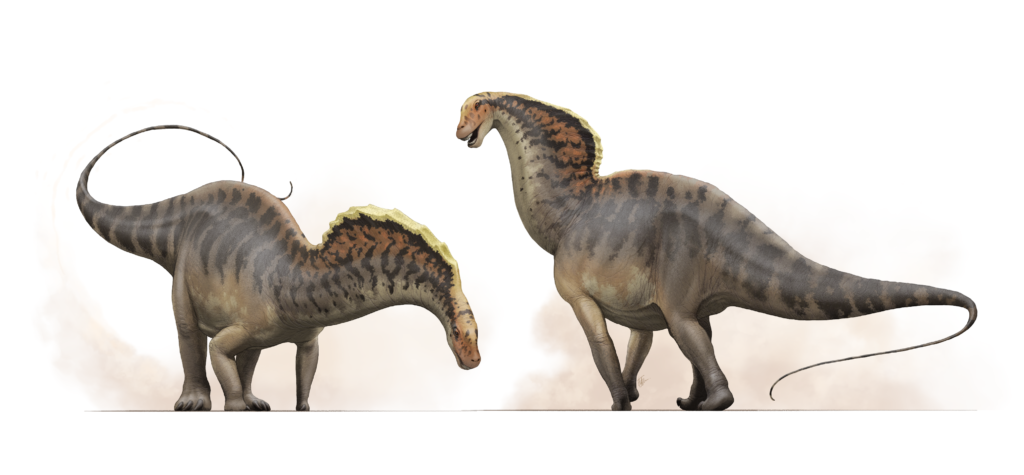
Among the most bizarre cranial structures of any dinosaur belongs to Amargasaurus, a sauropod from Early Cretaceous Argentina, approximately 129-122 million years ago. Unlike the head crests of many other dinosaurs, Amargasaurus possessed two parallel rows of tall, narrow neural spines that extended upward from its neck vertebrae, creating what resembled a dramatic sail or series of spikes along its neck. These peculiar extensions could reach lengths of up to 60 centimeters (2 feet), making them proportionally enormous relative to the dinosaur’s body size. Paleontologists have proposed several theories regarding the function of these unusual structures. One possibility is that they supported a sail-like membrane that could have helped regulate body temperature, similar to the proposed function of the sail on Dimetrodon, though this non-dinosaur lived much earlier. Alternative theories suggest these spines might have been covered with keratin sheaths, creating sharp defensive spikes that would have deterred predators from attacking the neck region. The most recent research indicates these spines may have been covered with a thick layer of fat and skin, creating a camel-like hump that could have served as an energy reserve during periods of food scarcity in its sometimes harsh South American environment.
The Spectacular Crest of Pachycephalosaurus
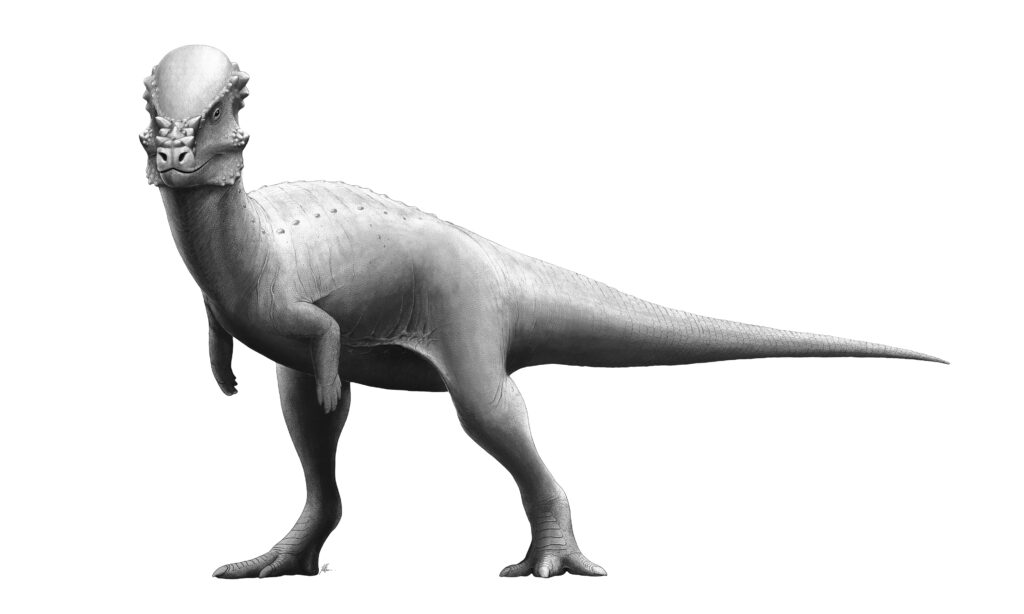
Though not traditionally considered a “crested” dinosaur in the same way as hadrosaurs, Pachycephalosaurus possessed one of the most extreme cranial modifications of any dinosaur—a massively thickened, domed skull roof that effectively formed a natural helmet. This Late Cretaceous dinosaur, living approximately 70-65 million years ago, developed a dome of solid bone that could reach thicknesses of up to 10 inches, making it proportionally the thickest skull of any known vertebrate. Unlike the ornamental or acoustic crests of other dinosaurs, this structure appears to have evolved primarily for physical combat. Microscopic studies of pachycephalosaur domes reveal evidence of healing injuries, suggesting these dinosaurs engaged in head-butting contests similar to modern rams or musk oxen. These competitions likely served as dominance displays between males competing for territory or mating rights. The dome’s surface was further adorned with knobs and spikes around its edges, creating an even more formidable appearance during confrontations. This extreme specialization represents one of the most dramatic examples of sexual selection in the dinosaur world, where physical combat capabilities directly influenced reproductive success.
Styracosaurus and Its Crown of Horns
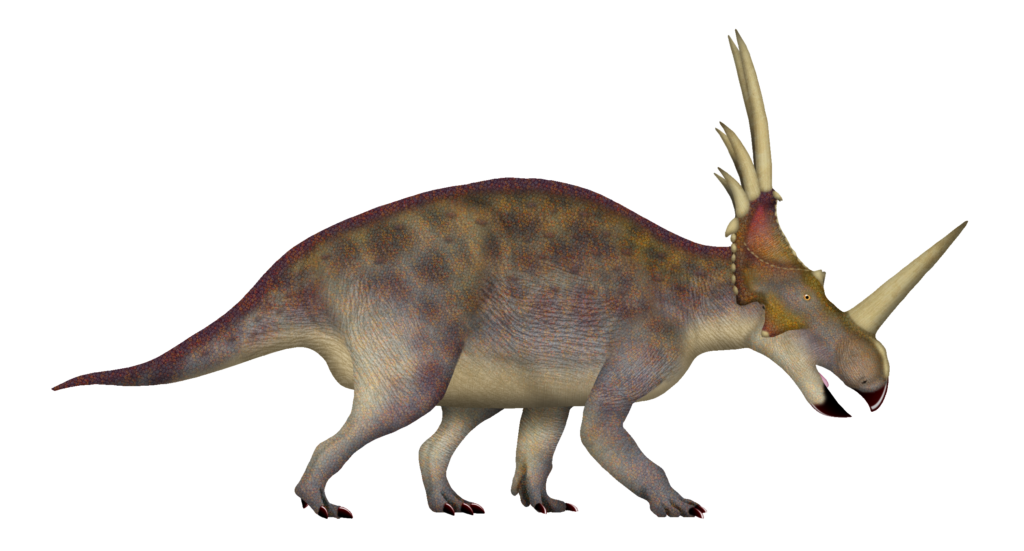
While technically classified as horns rather than a crest, the spectacular head ornamentation of Styracosaurus warrants mention for its extraordinary elaboration and visual impact. This ceratopsian dinosaur, living approximately 75.5-75 million years ago during the Late Cretaceous, possessed a spectacular array of horn-like projections that radiated outward from its neck frill, creating a crown-like appearance. The most prominent feature was a single large nasal horn that projected forward from the nose, while four to six additional long spikes extended from the margin of its neck frill. These impressive structures could reach lengths of up to two feet, giving Styracosaurus one of the most visually striking profiles of any dinosaur. Research suggests these elaborate horns served multiple functions, including defense against predators like Tyrannosaurus rex and Daspletosaurus. However, their symmetrical arrangement and extreme development point strongly toward their role in visual displays for mate attraction and species recognition. The variation in frill patterns between individuals may have allowed for recognition of specific animals within herds, potentially facilitating complex social structures similar to those seen in modern horned mammals like antelope and bison.
The Evolutionary Purpose Behind Dinosaur Crests

The remarkable diversity of cranial ornamentations among dinosaurs represents one of the most compelling examples of evolutionary adaptation in the fossil record. These structures did not develop randomly but rather emerged through millions of years of natural and sexual selection pressures that shaped them for specific biological purposes. For hadrosaurs with hollow, chamber-like crests, the primary function appears to have been acoustic—allowing for species-specific vocalizations that facilitated communication across distances in their respective habitats. For theropods and ceratopsians with solid crests and horns, visual signaling for species recognition and mate selection likely drove their development, with more elaborate structures potentially indicating genetic fitness to potential mates. Secondary functions also played important roles, with some crests potentially serving as thermoregulatory structures containing blood vessels that could help cool or warm the animal as needed. The tremendous energy investment required to grow and maintain these elaborate structures underscores their biological importance—dinosaurs would not have evolved such metabolically expensive features unless they provided significant survival or reproductive advantages. Modern comparative studies with crested birds, their closest living relatives, further support the multifunctional nature of these remarkable adaptations that helped dinosaurs thrive for over 165 million years.
Conclusion
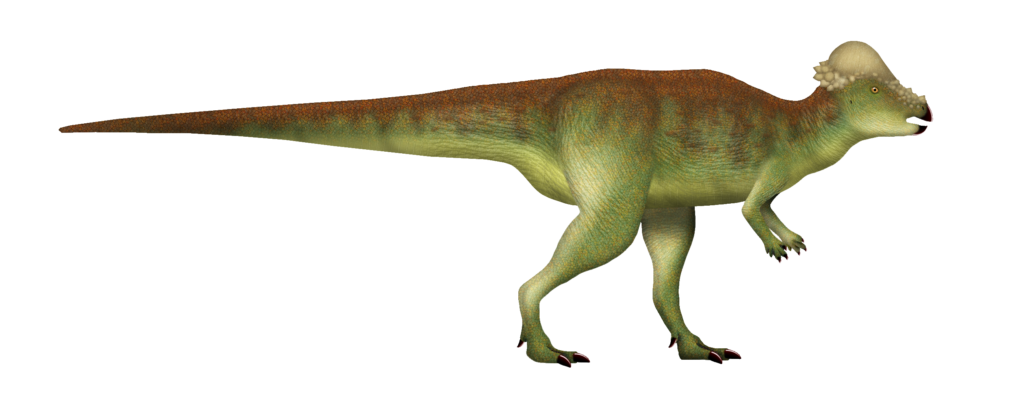
The extraordinary array of crests found among dinosaur species represents one of the most fascinating aspects of these prehistoric creatures’ anatomy. From the sound-amplifying hollow chambers of Parasaurolophus to the imposing dome of Pachycephalosaurus, these structures evolved to serve specific biological needs essential for survival and reproduction. Whether facilitating complex vocalizations, providing visual signals for mate selection, regulating body temperature, or even offering physical protection, dinosaur crests demonstrate the remarkable adaptability and diversity that characterized these animals. As paleontological techniques continue to advance, our understanding of these structures grows ever more sophisticated, offering glimpses into the complex behaviors and evolutionary pressures that shaped life during the Mesozoic Era. These magnificent crests stand as a testament to nature’s endless capacity for innovation, reminding us that form and function have always been inextricably linked throughout evolutionary history.

